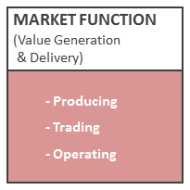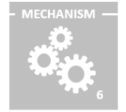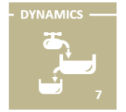The Market Function
Definition
The Market Function aims at providing value to the external world in the form of products (goods & services). As defined in the detailed view of the Business System, the targeted actors of this value may be customers, but also "beneficiaries", who do not pay the organization with cash.
The value that is provided to the Targets is created or increased through the Market Super-Process (VG&D: Value Generation & Delivery).
To deliver value, the Market Function is mostly based on the following 3 modes:
- 1- Producing: most of the delivered value is generated through the organization's processes
- 2- Trading: most of the delivered value is already included in the organizations' supplies
- 3- Operating: most of the delivered value consists in the usage of the organization's resources by its targets

Some organizations can be almost entirelly dedicated to the Market Function:
- A time limited Joint-Venture between two industrials for the realization of a contract is mainly focused on its Market Function (its mission as such is not to earn money, as the contract was signed already with the customer).
- Similarly, a factory, inside an industrial group, is also mainly focused on its Market Function. Its business is about delivering products to its customer (which may be another entity in the group).
Examples
Here are a few examples illustrating the different modes of the Market Function:
1- Producing:
- Carmakers produce vehicles. They used to manufacture most of them, and are now more assemblers,
- CNN produces a great part of its programs, as opposed to TV channels broadcasting programs they buy from outside,
- 3 stars restaurants prepare their meals: they do not just resell meals that were prepared elsewhere,
- Hospitals usually deliver services that they actually perform,
- Taxi drivers or taxi companies provide a service that they actually perform.
2- Trading:
- Mobile virtual network operator dont not operate their own network: most of the delivered value is traded,
- Tour operators trade hotel nights and other tourism-related services,
- Many TV channels do not produce their programs: the value delivery to viewers follows the trading mode,
- Supermarkets trade products that they buy from suppliers,
- Apple trades apps and music online.
3- Operating:
- National electricity suppliers usually operate their own network, that their customers use,
- Disneyland operates parks that their customers enjoy,
- Hotels operate buildings that their customers use,
- Salesforce operates a software on its servers, that its customers use,
- Avis operates fleets of vehicles that their customers drive,
- Angry Birds' business is widely based on the use of the brand by licensees,
- Shopping malls operate real estate that shops use.
The Market Function may be handled in very different ways:
The Market Function can be two-sided. The Market Function of NBC TV broadcasting business is basically split in 2:
- Broadcasting programs towards the television audience,
- Providing advertising spots to advertisers.
The Market Function can be multi-sided. Apple's Market Function for its iPhone/iPad business, mostly consists in:
- Providing a platform for software editors to sell their products, get user's data and sell ads,
- Providing to consumers phones and tablets, and potential access to software editor's products,
- Providing services accessible from these devices (such as music) to consumers,
- Providing audience to advertisers through applications,
- Providing a way to sell bandwidth to mobile phone network operators.
The Market Function may not only be directed to customers. In the case of a company like McKinsey, it aims at:
- Providing qualitative consulting services to Fortune 500 companies, but also:
- Providing prestige and valuable experience to top business schools alumni the company tries to attract.
Market Function Strategy
The Market Function focuses on the VG&D Super-Process (Value Generation & Delivery). That may mean focusing on the VG&D Super-Process in terms of:
- Quantity of outputs: quantity of what is delivered
- Quality of outputs: quality of what is delivered
A strategy mainly focused on the Market Function is usual in markets mainly driven by the supply side rather than the demand side. In such a case, the objective of the organization is to be able to deliver as much as possible. For a manufacturing business, it means focusing on the production capacity.
In markets that are driven by the demand side, an organization can choose a strategy focused on the Market Function when quality is required. Consulting companies usually follow such a strategy in order to secure recurring business.
In a demand-driven market, a strategy focused on the Market Function can also be followed for a specific phase when quantities are key. For instance, a web-based start-up may be willing to provide as much value to its users as possible, even for free, in order to increase its market share in terms of audience, before switching to a next business phase focused on monetization of this audience.









